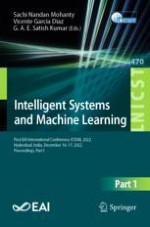2023 | Buch
Intelligent Systems and Machine Learning
First EAI International Conference, ICISML 2022, Hyderabad, India, December 16-17, 2022, Proceedings, Part I
herausgegeben von: Sachi Nandan Mohanty, Vicente Garcia Diaz, G. A. E. Satish Kumar
Verlag: Springer Nature Switzerland
Buchreihe : Lecture Notes of the Institute for Computer Sciences, Social Informatics and Telecommunications Engineering
